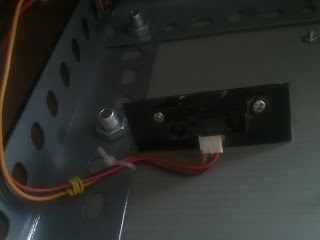Title : Designing the PCB (Printed
Circuit Board).
Objective : To design the PCB layout by printing the PCB circuit, etching, drilling, placed
the components, soldering the components and testing the circuits.
Procedures: 1) The design of a Printed
Circuit Board (PCB) layout of the system was printed on the Overhead Projector (OHP) plastic.
Figure 1: PCB layout printed on OHP paper
2)
The masking tape had been
used to stick the printed OHP plastic with copper board and make sure there was
no air bubble between both. This is the important step so that the circuit had
been transfer perfectly onto the PCB board without any broken connection.
Figure 2: Masking tape had been stick with copper board
3)
Then, a paper or cloth had been
covered on the board to avoid the plastic melts due to the transparency of its
hot iron. The iron had been set to ‘Linen' or as high as the iron will go. A
fairly hot iron was needed because the toner had been forced to melt and
subsequently bond to the copper blank PCB.
Figure 3: Ironing the covered board
4)
Then, the ironed circuit had been
leaved for a while to cool it down. Do not remove the masking tape when the
board still hot. After it cool, the masking tape had been removed. The circuit that
been iron had been shown below.
Figure 4: The circuit after been ironed
5)
Next the connection of the
circuit had been check by using the multimeter. The multimeter had been set to
‘beep’ sound. The multimeter will produce a ‘beep’ sound when the connection is
connected to each other. If no ‘beep’ sound was produce, the connection might
be broken.
Figure 5: The connection had been check using multimeter
6) The defects connection had been touch up by using permanent marker pen 700 artline.
Figure 6: 700 artline permanent marker had been use to touch up the defects connection
7)
Next, the etching process had
been proceed by pouring some hydrochloric acid
on a plastic container and soak in the copper board into the acid. The
container then had been shaking slowly to remove the copper layout from the
board.
Figure 7: The copper board had been soak into the Hydrochloric acid
8)
Then the circuit board had been washed using
clean running water and been brushed with very fine grade of sand paper. This will remove dirt, oils and
other contamination on the top of the PCB board. After rinse, the board had
been dried quickly by wiping it with towels wet with acetone. The wiping step
had been repeated as many times needed until the paper towel comes off
completely clean. The board had been dried quickly to avoid oxidization.
Figure 8:The circuit
after etching
9)
Next the etching circuits
had been clean by rubbing the circuit with very fine sand paper to remove the copper layer.
Figure 9: The etching circuits had been clean with very fine sand paper
10)
Then the circuit
had been drill to make a hole for electronic component placement.
Figure 10: The circuit had been drill by using hand drill
Figure 11: The
PCB board after being drilled
11)
Next,
the component had been placed by referring the schematic diagram and been
soldered.
Figure 12: The component had been soldered
12) After that, the component leg had been cut
off by using a cutter.
Figure 13: The soldered component's leg had been cut
13) The connection of the circuit had been check
again by using multimeter. The multimeter
had been set to ‘beep’ sound. The multimeter will produce a ‘beep’ sound when
the connection is connected to each other.
Figure 14: The connection had been check using multimeter
14)
If no ‘beep’ sound was produce,
the connection might be broken. The connection can be overcome by soldering a
little jumper wire on downside of the PCB board to make it connected.
Figure 15: The jumper wire had been soldered to the defected circuit connection
Figure 16:
The final PCB board after being through the above step
Conclusion:
Basically, the PCB process consisting six processes which are printing the PCB
circuit, etching, drilling, placed the components, soldering the components and
testing the circuits.















































